Mexico’s culinary scene is a vibrant tapestry of flavors, offering much more than just the familiar tacos and burritos; explore the best Mexican cuisine with gaymexico.net, your ultimate guide to LGBTQ+ friendly experiences in Mexico. Authentic Mexican food provides a delightful experience for your senses. Whether you’re a seasoned foodie or a curious traveler, prepare to be amazed by the diverse gastronomy, cultural richness, and queer-friendly atmosphere Mexico has to offer. With a focus on authentic Mexican dishes and local culinary experiences, let’s dive into the heart of Mexican cuisine and discover the must-try dishes that define this incredible destination.
1. What Makes Mexican Birria A Culinary Sensation?
Birria is a traditional Mexican stew, and it has surged in popularity, introducing countless food enthusiasts to its unique and delicious taste. This flavorful stew is typically made from meat, often goat or lamb, which is seasoned and braised to perfection. The preparation often includes dried chilis, lime, Mexican oregano, and cinnamon, creating a rich, complex flavor profile. Birria is more than just a dish; it’s a culinary experience that connects you to the heart of Mexican tradition.
Fun Fact: Birria originates from the northern Mexican region of Jalisco. This dish, deeply rooted in Jalisco’s culinary heritage, has become a symbol of Mexican gastronomy, captivating palates worldwide.
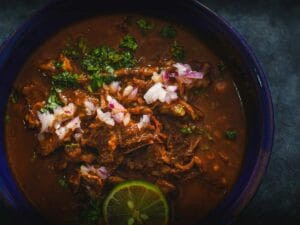 Bowl of Birria Stew garnished with cilantro and onions
Bowl of Birria Stew garnished with cilantro and onions
2. What Are Gorditas And Why Are They A Street Food Favorite?
Gorditas are a beloved Mexican street food, consisting of thick corn tortillas stuffed with a variety of delicious fillings such as meat, cheese, and beans. Their simplicity and taste make them a popular choice for a quick and satisfying meal.
Fun Fact: “Gordita” translates to “little fatty” in Spanish, referring to the round, thick shape of the tortillas. This playful name reflects the hearty and satisfying nature of this popular street food.
3. How Did Churros Become A Mexican Dessert Staple?
Churros, originally from Spain, have become a cornerstone of Mexican desserts. Enjoying a fresh, hot churro with a side of chocolate in Mexico offers an unparalleled culinary experience.
Fun Fact: Churros were introduced to Mexico during the Spanish Inquisition in the 16th century. Their acceptance into Mexican cuisine highlights the cultural exchange and culinary adaptation that defines Mexican gastronomy.
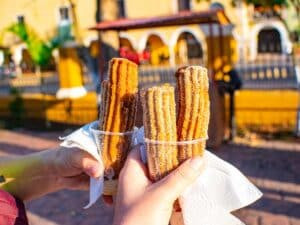 Golden brown Churros served with a side of chocolate sauce
Golden brown Churros served with a side of chocolate sauce
4. What Distinguishes Tacos Al Pastor From Other Tacos?
Tacos al pastor stand out due to their unique preparation and historical roots. This popular taco dish features thinly sliced pork, slow-roasted on a spit with pineapple, coriander leaves, and onions, all served on a corn tortilla. The combination of flavors and cooking method sets it apart from other taco variations.
Fun Fact: “Tacos al pastor” means “in the style of the shepherd.” This name comes from the traditional cooking method, where marinated pork is roasted on a vertical spit, similar to how shepherds in Mexico roast meat over an open flame.
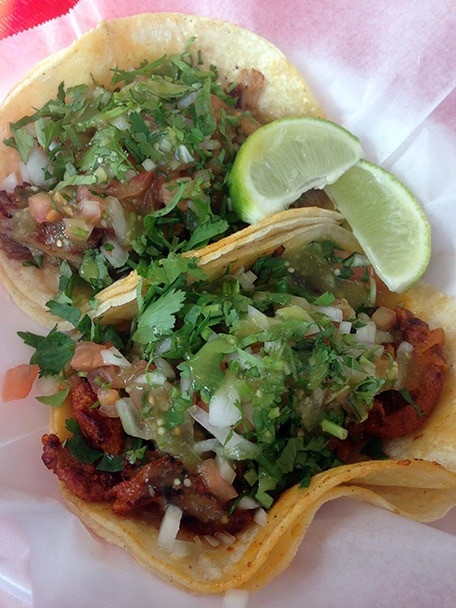 Close-up of authentic Mexican al pastor tacos with toppings
Close-up of authentic Mexican al pastor tacos with toppings
5. How Are Tostadas Made And What Are They Typically Served With?
Tostadas are made from stale tortillas that are fried until crispy. These fried tortillas are then topped with cheese, meats, vegetables, and various garnishes, making for a filling and versatile dish.
Fun Fact: Tostadas are believed to have originated from Mesoamerican civilizations thousands of years ago. This ancient origin underscores the historical depth and cultural significance of this simple yet satisfying dish.
6. What Are Chilaquiles And Why Are They A Popular Breakfast Choice?
Chilaquiles are a popular Mexican breakfast dish featuring lightly-fried tortillas cut into smaller pieces, topped with salsa and a variety of breakfast foods such as eggs, cheeses, cream, or chicken. They are typically served with a generous side of refried beans (frijoles).
Fun Fact: “Chilaquiles” comes from the ancient Aztec Nahuatl word for “chilis and greens.” This etymological connection highlights the dish’s indigenous roots and its long-standing presence in Mexican cuisine.
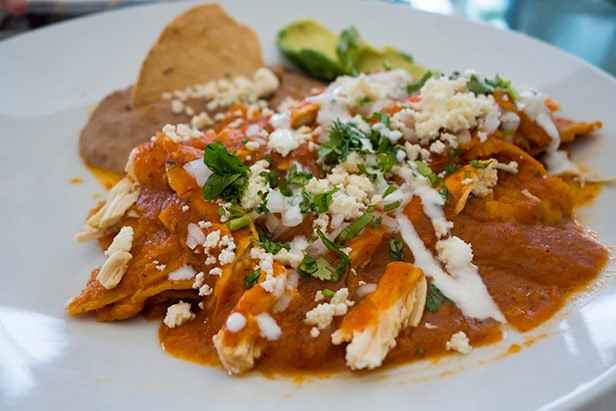 Overhead shot of a Chilaquiles dish with various toppings
Overhead shot of a Chilaquiles dish with various toppings
7. What Is Unique About Chiles En Nogada?
Chiles en nogada is a dish that is both patriotic and delicious. The ingredients represent the colors of the Mexican flag, featuring a mixture of fruits, spices, and chopped meat stuffed into Poblano chiles (green), drizzled with a walnut-based cream sauce (white), and sprinkled with pomegranate seeds (red).
Fun Fact: Chiles en nogada were first made by Augustinian nuns who were asked to create a patriotic dish to celebrate Mexican independence and the arrival of Mexican Emperor Agustín de Iturbide. This historical origin adds a layer of cultural significance to the dish, making it a symbol of Mexican identity.
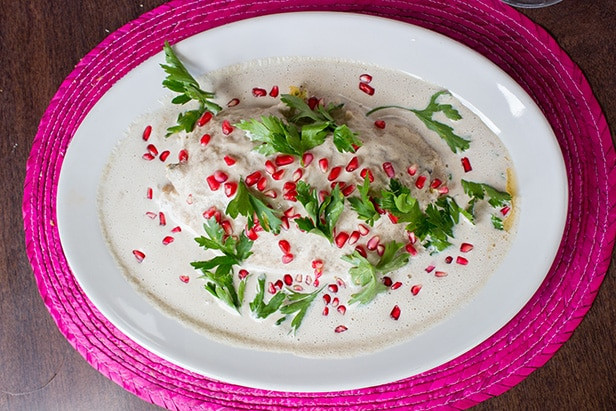 Chiles en Nogada dish beautifully plated with garnish
Chiles en Nogada dish beautifully plated with garnish
8. What Are The Key Ingredients And Preparation Of Pozole?
Pozole is a rich, spicy, and extremely popular soup made from hominy corn. It is often stewed overnight with herbs and spices, along with chicken, pork, or vegetables. When served, it is accompanied by onions, radishes, limes, lettuce, and chilies.
Fun Fact: “Pozole” also comes from the ancient Aztec Nahuatl language, meaning “hominy” or “foamy.” Hominy is a key ingredient, made from shelled, dried kernels of field corn soaked in a mineral-lime mixture. This ancient preparation method emphasizes the dish’s deep-rooted connection to Mexican history and culture.
9. What Are Enchiladas And How Are They Typically Served?
Enchiladas are made with either corn or flour tortillas, stuffed with various ingredients such as meat, seafood, or vegetables. They are often drizzled with chili sauce and topped with garnishes. Enchiladas are commonly eaten for breakfast in Mexico but are enjoyable at any time of day.
Fun Fact: Enchiladas were featured in the very first Mexican cookbook published in 1831. This early recognition highlights the dish’s enduring popularity and its place in the canon of Mexican cuisine.
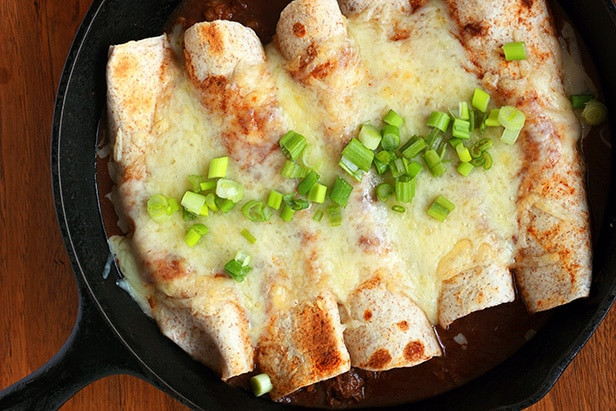 Enchiladas in a cast iron pan topped with cheese and sauce
Enchiladas in a cast iron pan topped with cheese and sauce
10. What Are Tamales And How Are They Prepared?
Tamales are a popular Mexican street food consisting of steamed pockets of dough made from corn and stuffed with a variety of fillings. They are typically wrapped in cornhusks or banana leaves during steaming. Fillings can include chilies, vegetables, meats, fruits, and cheeses.
Fun Fact: Tamales were originally eaten during religious and cultural celebrations by ancient civilizations like the Aztecs, Maya, and Olmecs. This ancient tradition underscores the cultural significance of tamales in Mexican society.
11. What Is Elote And What Makes It Special?
Elote is corn on the cob, often served with an abundance of spices and garnishes such as lime, sour cream, salt, chili powder, and cheese.
Fun Fact: Elote is one of the most popular street foods in Mexico. Its widespread popularity reflects the simple yet satisfying flavors that define Mexican street cuisine.
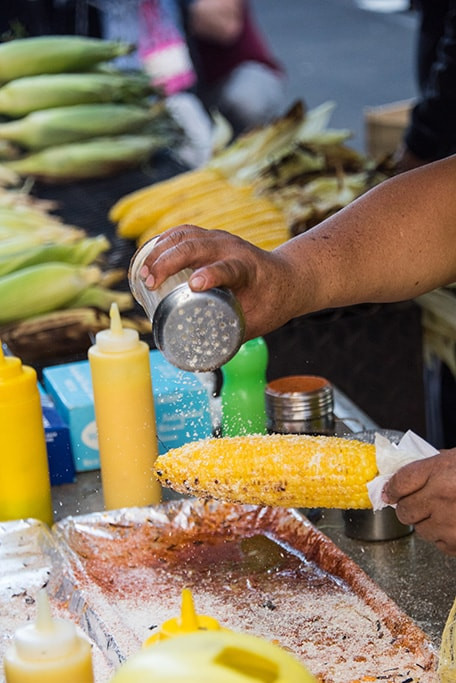 Hands preparing Elote with various toppings
Hands preparing Elote with various toppings
12. Beyond The Main Dishes, What Other Mexican Food Should You Try?
In addition to the main dishes, don’t miss out on other tasty traditional Mexican foods that can elevate your meal. Mole is a rich sauce often used in Mexican cuisine, made with different types of chili peppers and chocolate, often served over meats. Guacamole is a great accompaniment to many dishes, made with mashed avocados, onions, chili peppers, lemon juice, and tomatoes.
13. How Can I Ensure A Safe And Welcoming Culinary Experience As An LGBTQ+ Traveler In Mexico?
Planning a culinary adventure in Mexico as an LGBTQ+ traveler involves a few considerations to ensure a safe and welcoming experience. Mexico has become increasingly LGBTQ+ friendly, especially in tourist destinations. Researching and choosing LGBTQ+ friendly establishments can significantly enhance your travel experience. Here are some tips:
- Research LGBTQ+ Friendly Destinations: Cities like Puerto Vallarta, Mexico City, and Cancun are known for their welcoming atmosphere and vibrant LGBTQ+ scenes.
- Use LGBTQ+ Travel Resources: Websites like gaymexico.net provide valuable information on LGBTQ+ friendly accommodations, restaurants, and activities.
- Read Reviews: Check reviews from other LGBTQ+ travelers to get insights into the experiences at different establishments.
- Be Aware of Local Laws and Customs: While Mexico is generally accepting, it’s always good to be aware of local laws and customs to ensure respectful and safe interactions. According to the Human Rights Watch, Mexico has made significant strides in LGBTQ+ rights, including legalizing same-sex marriage nationwide. However, attitudes can vary by region, so staying informed is crucial.
- Connect with Local LGBTQ+ Communities: Engaging with local LGBTQ+ communities can provide you with insider tips and a deeper understanding of the local culture.
14. What Are Some Must-Try Regional Mexican Dishes For LGBTQ+ Travelers?
Mexico’s regional cuisines offer a diverse range of flavors and experiences. For LGBTQ+ travelers looking to explore local culinary delights, here are some must-try dishes:
| Regional Dish | Description | Region | LGBTQ+ Friendly Areas |
|---|---|---|---|
| Mole Negro | A complex sauce made with chili peppers, chocolate, spices, and nuts, typically served with chicken or turkey. | Oaxaca | Oaxaca City has a growing LGBTQ+ scene with several welcoming restaurants and bars. |
| Cochinita Pibil | Slow-roasted pork marinated in achiote paste, citrus juice, and spices, often served in tacos or tortas. | Yucatan | Merida, the capital of Yucatan, is known for its progressive atmosphere and LGBTQ+ friendly establishments. |
| Birria | A spicy stew made with goat or beef, marinated in chili peppers and spices, often served with tortillas and garnishes. | Jalisco | Puerto Vallarta is a renowned LGBTQ+ destination with numerous gay-friendly restaurants offering local cuisine. |
| Chiles en Nogada | Poblano peppers stuffed with a mixture of fruits, nuts, and meat, covered in a walnut cream sauce and pomegranate seeds. | Puebla | Puebla City offers a mix of traditional and modern culinary experiences with many inclusive dining options. |
| Tlayudas | Large, crispy tortillas topped with beans, cheese, lettuce, avocado, and your choice of meat, often referred to as “Mexican pizza.” | Oaxaca | Explore LGBTQ+ friendly cafes and restaurants in Oaxaca City that serve authentic Tlayudas. |
| Seafood Cocktails | Fresh seafood such as shrimp, octopus, and fish marinated in lime juice, mixed with vegetables, and served in a flavorful broth. | Coastal Regions | Coastal cities like Cancun and Playa del Carmen have numerous seafood restaurants catering to LGBTQ+ travelers. |
| Esquites | Corn kernels sautéed with butter, chili, lime, and cotija cheese, served in a cup or on a stick. | Mexico City | Enjoy Esquites from street vendors in Mexico City’s gay-friendly neighborhoods like Zona Rosa. |
| Churros Rellenos | Classic churros filled with creamy flavors like cajeta (caramel), chocolate, or vanilla, perfect for satisfying your sweet tooth. | Guanajuato | Visit LGBTQ+ friendly cafes in San Miguel de Allende for a delightful churros experience. |
| Tamales | Corn dough pockets filled with savory or sweet ingredients like meat, cheese, vegetables, or fruits, wrapped in corn husks or banana leaves and steamed until tender. | Nationwide | Discover regional variations of Tamales at local markets and restaurants throughout Mexico. |
| Tacos Al Pastor | Marinated pork cooked on a vertical spit and shaved onto small corn tortillas, topped with pineapple, cilantro, and onions. | Mexico City | Find Tacos Al Pastor at street food stalls and taquerias in Mexico City’s LGBTQ+ friendly areas. |
15. How Can LGBTQ+ Travelers Find Authentic And Welcoming Culinary Experiences In Mexico?
Finding authentic and welcoming culinary experiences in Mexico as an LGBTQ+ traveler involves a mix of research, networking, and openness. Here are some strategies to ensure a fulfilling culinary journey:
- Utilize LGBTQ+ Travel Guides: Resources like gaymexico.net offer curated lists of LGBTQ+ friendly restaurants, bars, and cafes.
- Read Online Reviews: Platforms like Yelp, TripAdvisor, and Google Reviews often provide insights into the experiences of LGBTQ+ patrons.
- Join LGBTQ+ Travel Groups: Online communities on Facebook and other platforms can offer firsthand recommendations and tips from fellow travelers.
- Ask Locals: Don’t hesitate to ask local residents for recommendations. Hotel staff, tour guides, and shopkeepers can often point you to hidden gems.
- Explore Diverse Neighborhoods: Venture beyond tourist hotspots and explore diverse neighborhoods where you’re more likely to find authentic and inclusive culinary experiences.
- Attend Culinary Events: Look for food festivals, cooking classes, and culinary tours that celebrate Mexican cuisine and culture. These events often attract a diverse crowd and offer opportunities to connect with locals and fellow travelers.
- Support Local Businesses: Choose to dine at locally-owned restaurants and cafes that prioritize inclusivity and community engagement.
- Be Open and Respectful: Approach each culinary experience with an open mind and a willingness to learn about Mexican culture. Show respect for local customs and traditions, and engage with restaurant staff and fellow diners in a friendly and courteous manner.
- Use Translation Apps: In areas where English is not widely spoken, translation apps can help you communicate your needs and preferences to restaurant staff.
- Trust Your Instincts: If you ever feel uncomfortable or unwelcome at an establishment, trust your instincts and choose to dine elsewhere.
16. How Does Mexican Food Reflect The Country’s Cultural Diversity?
Mexican food is a vibrant reflection of the country’s rich cultural diversity, shaped by a blend of indigenous traditions, Spanish colonial influences, and regional variations. This culinary tapestry tells a story of history, geography, and cultural exchange.
- Indigenous Roots: Many staple ingredients in Mexican cuisine, such as corn, beans, chili peppers, avocados, and tomatoes, have been cultivated in Mexico for thousands of years. Traditional dishes like tamales, pozole, and mole have their origins in pre-Columbian civilizations like the Aztecs and Mayans.
- Spanish Colonial Influences: The arrival of the Spanish in the 16th century brought new ingredients and cooking techniques to Mexico. Wheat, rice, dairy products, and various meats like pork and beef were introduced, leading to the creation of fusion dishes like enchiladas, chiles en nogada, and churros.
- Regional Variations: Mexico’s diverse geography and climate have given rise to distinct regional cuisines. For example, Oaxaca is known for its complex moles and tlayudas, while Yucatan is famous for cochinita pibil and sopa de lima. Each region boasts its own unique flavors, ingredients, and culinary traditions.
- Cultural Celebrations: Food plays a central role in Mexican cultural celebrations like Día de Muertos (Day of the Dead), Cinco de Mayo, and Christmas. Special dishes are prepared for these occasions, often with symbolic meanings and traditional recipes passed down through generations.
- Street Food Culture: Mexican street food is an integral part of the country’s culinary identity, offering a wide array of affordable and delicious dishes like tacos, elote, and churros. Street food vendors often use traditional cooking methods and family recipes, providing an authentic taste of Mexican culture.
- Global Influences: In recent years, Mexican cuisine has been influenced by global culinary trends, leading to the creation of innovative fusion dishes and modern interpretations of traditional recipes. However, Mexican chefs and cooks remain committed to preserving the authenticity and cultural heritage of their cuisine.
17. What Legal Protections And Social Attitudes Exist For LGBTQ+ Individuals In Mexico?
Mexico has made significant strides in LGBTQ+ rights and protections in recent years, although social attitudes can vary across the country. Here’s an overview of the legal landscape and social climate for LGBTQ+ individuals in Mexico:
- Same-Sex Marriage: Same-sex marriage is legal throughout Mexico. In 2015, the Supreme Court ruled that state bans on same-sex marriage were unconstitutional. As of 2022, all 32 states have legalized same-sex marriage, either through legislative action or court order.
- Adoption Rights: LGBTQ+ couples have the right to adopt children in Mexico. The Supreme Court has ruled that discriminatory adoption laws are unconstitutional, ensuring equal adoption rights for same-sex couples.
- Anti-Discrimination Laws: Mexico has federal anti-discrimination laws that protect LGBTQ+ individuals from discrimination in employment, housing, healthcare, and other areas. These laws prohibit discrimination based on sexual orientation and gender identity.
- Gender Identity Recognition: Mexico recognizes the right of transgender individuals to change their legal gender on official documents. The process for changing gender varies by state but generally involves submitting a request to the civil registry.
- Hate Crime Laws: Mexico has federal hate crime laws that protect LGBTQ+ individuals from violence and discrimination. These laws enhance penalties for crimes motivated by bias based on sexual orientation or gender identity.
- Social Attitudes: While legal protections for LGBTQ+ individuals have advanced, social attitudes can vary across Mexico. Major cities like Mexico City, Guadalajara, and Puerto Vallarta are generally more accepting and LGBTQ+ friendly than rural areas. Public displays of affection may be met with mixed reactions depending on the location.
- LGBTQ+ Community: Mexico has a vibrant LGBTQ+ community with numerous organizations, events, and resources. Cities like Mexico City and Puerto Vallarta host annual Pride celebrations and have established LGBTQ+ neighborhoods with gay bars, clubs, and cultural centers.
- Challenges and Issues: Despite progress, LGBTQ+ individuals in Mexico still face challenges such as discrimination, stigma, and violence. Transgender individuals, in particular, are vulnerable to discrimination and violence. Efforts are ongoing to promote greater acceptance, understanding, and equality for LGBTQ+ people in Mexico.
According to the UCLA Williams Institute, as of July 2025, LGBTQ+ inclusive policies have a positive impact on economic growth and social well-being in Mexico.
18. What Safety Tips Should LGBTQ+ Travelers Keep In Mind While Exploring Mexico’s Culinary Scene?
While many areas in Mexico are welcoming to LGBTQ+ travelers, it’s essential to stay informed and take necessary precautions to ensure a safe and enjoyable experience. Here are some safety tips for LGBTQ+ travelers exploring Mexico’s culinary scene:
- Research LGBTQ+ Friendly Establishments: Before visiting a restaurant or bar, research its reputation for LGBTQ+ inclusivity. Look for reviews and recommendations from other LGBTQ+ travelers to gauge the establishment’s welcoming atmosphere.
- Be Aware of Local Customs: While Mexico has made progress in LGBTQ+ rights, social attitudes can vary by region. Be mindful of local customs and traditions, and avoid public displays of affection in areas where they may not be well-received.
- Stay Informed About Local Laws: Familiarize yourself with local laws and regulations related to LGBTQ+ rights. While same-sex marriage is legal nationwide, discriminatory practices may still occur in some areas.
- Trust Your Instincts: If you ever feel uncomfortable or unsafe in a particular establishment or neighborhood, trust your instincts and leave. Your safety and well-being should always be a top priority.
- Avoid Isolated Areas: Stick to well-lit and populated areas, especially at night. Avoid walking alone in unfamiliar or isolated neighborhoods, where you may be more vulnerable to harassment or crime.
- Use Reputable Transportation Services: When traveling to and from restaurants and bars, use reputable transportation services such as Uber, taxis, or authorized shuttle services. Avoid accepting rides from unofficial or unlicensed drivers.
- Keep Valuables Secure: Protect your belongings from theft by keeping valuables such as wallets, phones, and passports secure. Use a money belt or hidden pouch to store important documents and cash.
- Stay Connected: Keep your phone charged and accessible, and share your itinerary with a trusted friend or family member. Stay in contact with them regularly and let them know of any changes to your plans.
- Learn Basic Spanish Phrases: Learning a few basic Spanish phrases can help you communicate with restaurant staff and locals. Knowing how to say “hello,” “thank you,” and “excuse me” can go a long way in fostering positive interactions.
- Report Incidents: If you experience or witness any incidents of harassment, discrimination, or violence, report them to the local authorities and LGBTQ+ organizations. Your report can help raise awareness and prevent future incidents.
19. Where Can LGBTQ+ Travelers Find The Best Resources And Information About Mexican Cuisine?
LGBTQ+ travelers seeking the best resources and information about Mexican cuisine can find a wealth of knowledge from various sources. Here are some top resources to explore:
- LGBTQ+ Travel Websites: Websites like gaymexico.net offer dedicated sections on Mexican cuisine, highlighting LGBTQ+ friendly restaurants, culinary tours, and regional specialties. These platforms often provide insider tips and recommendations from fellow LGBTQ+ travelers.
- Food Blogs and Websites: Numerous food blogs and websites focus on Mexican cuisine, offering recipes, restaurant reviews, and cultural insights. Look for blogs that emphasize regional dishes and traditional cooking methods.
- Travel Guidebooks: Travel guidebooks such as Lonely Planet, Fodor’s, and Frommer’s often include detailed information about Mexican cuisine, including restaurant recommendations, culinary tours, and regional food guides.
- Online Culinary Communities: Online culinary communities and forums such as Reddit’s r/mexicanfood and Facebook groups dedicated to Mexican cuisine provide a platform for food enthusiasts to share recipes, ask questions, and exchange recommendations.
- Social Media: Social media platforms like Instagram, Facebook, and Twitter can be valuable resources for discovering Mexican cuisine. Follow food bloggers, chefs, and restaurants that specialize in Mexican dishes to stay updated on the latest culinary trends and hidden gems.
- Cultural Centers and Museums: Cultural centers and museums dedicated to Mexican culture often host culinary events, cooking classes, and exhibitions that showcase the country’s rich culinary heritage.
- Local Markets and Food Tours: Visiting local markets and participating in food tours can provide firsthand experiences of Mexican cuisine. Local guides can offer insights into traditional ingredients, cooking methods, and regional specialties.
- Cooking Classes: Taking a Mexican cooking class can be a fun and educational way to learn about the country’s culinary traditions. Many cooking schools and culinary centers offer classes tailored to different skill levels and interests.
- Libraries and Bookstores: Libraries and bookstores offer a wide selection of cookbooks, culinary guides, and travelogues that focus on Mexican cuisine. Look for books that emphasize regional dishes and traditional cooking methods.
- University Research: According to research from the UCLA Williams Institute, as of July 2025, inclusive tourism, including LGBTQ+ tourism, significantly contributes to the economic growth of many regions in Mexico, promoting cultural exchange and understanding.
20. What Are Some Common Misconceptions About Mexican Food That You Should Know?
There are several common misconceptions about Mexican food that many people hold. Here are some of the most prevalent myths and the truths behind them:
- Misconception: Mexican food is always spicy.
- Truth: While some Mexican dishes do have a spicy kick, not all Mexican food is fiery. Many dishes are mild and flavorful, relying on a blend of herbs, spices, and ingredients to create complex flavors. Chili peppers are often served on the side, allowing individuals to adjust the spice level to their preference.
- Misconception: Mexican food is unhealthy.
- Truth: Mexican cuisine can be incredibly nutritious, featuring fresh ingredients like vegetables, fruits, beans, and lean proteins. Traditional Mexican dishes often incorporate whole foods and avoid excessive amounts of fats and processed ingredients. However, like any cuisine, moderation and balanced choices are key to maintaining a healthy diet.
- Misconception: Mexican food is all about tacos and burritos.
- Truth: While tacos and burritos are popular and delicious, they represent only a small fraction of the vast and diverse world of Mexican cuisine. Mexico boasts a rich culinary heritage with a wide array of regional dishes, including mole, pozole, enchiladas, tamales, and chiles en nogada.
- Misconception: Authentic Mexican food is the same everywhere.
- Truth: Mexican cuisine varies significantly from region to region, with each area boasting its own unique flavors, ingredients, and culinary traditions. For example, Oaxaca is known for its complex moles and tlayudas, while Yucatan is famous for cochinita pibil and sopa de lima.
- Misconception: Mexican food is always heavy and greasy.
- Truth: While some Mexican dishes may be rich and indulgent, many others are light and refreshing. Dishes like ceviche, ensalada de nopales, and sopa de lima are examples of light and healthy Mexican options.
- Misconception: Mexican food is the same as Tex-Mex.
- Truth: Tex-Mex is a fusion cuisine that combines elements of Mexican and American cooking. While Tex-Mex dishes like chili con carne and nachos are popular, they are distinct from authentic Mexican cuisine, which emphasizes traditional ingredients and cooking methods.
- Misconception: Mexican food is cheap and low-quality.
- Truth: While Mexican street food can be affordable and delicious, Mexican cuisine also encompasses high-end dining experiences that showcase the country’s culinary artistry. Many upscale restaurants and chefs are elevating Mexican cuisine with innovative dishes and refined presentations.
Mexico is waiting to welcome you with open arms and a table full of delectable dishes. Whether you’re craving savory tacos, hearty stews, or sweet churros, Mexico’s culinary landscape has something to delight every palate.
Ready to embark on a culinary journey through Mexico? Visit gaymexico.net for more information on LGBTQ+ friendly destinations, restaurants, and cultural experiences. Contact us at Address: 3255 Wilshire Blvd, Los Angeles, CA 90010, United States. Phone: +1 (213) 380-2177, and let us help you plan your unforgettable adventure! Explore local culinary delights, connect with the LGBTQ+ community, and create memories that will last a lifetime. Don’t wait – your Mexican adventure awaits!
